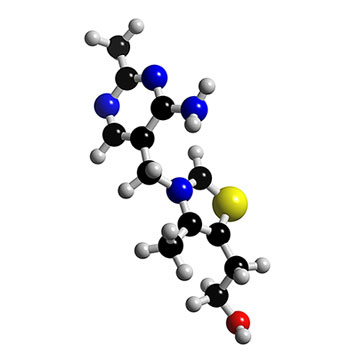By Laurie Barclay, MD
Medscape Medical News

June 3, 2010 — High-dose B vitamin therapy may not be helpful in diabetic nephropathy, according to the results of a multicenter, randomized, double-blind, controlled trial reported in the April 28 issue of the Journal of the American Medical Association. Compared with placebo, high doses of B vitamins were actually associated with a greater decrease in glomerular filtration rate (GFR) and an increase in vascular events.
"Hyperhomocysteinemia is frequently observed in patients with diabetic nephropathy," write Andrew A. House, MD, from University of Western Ontario in London, Ontario, Canada, and colleagues. "B-vitamin therapy (folic acid, vitamin B6, and vitamin B12) has been shown to lower the plasma concentration of homocysteine."
The goal of the study was to examine whether B vitamin supplementation would slow progression of diabetic nephropathy and reduce the risk for vascular complications. Between May 2001 and July 2007, a total of 238 patients with type 1 or type 2 diabetes and clinically diagnosed diabetic nephropathy were enrolled and observed in the Diabetic Intervention with Vitamins to Improve Nephropathy trial at 5 university medical centers in Canada.
"This is a rather large, very well-designed, randomized double-blind study with a reasonable follow-up time," Troels Krarup Hansen, MD, PhD, associate professor of endocrinology and internal medicine at Aarhus University Hospital in Denmark, told Medscape Diabetes & Endocrinology when asked for independent comment. "The patient cohort is homogenous and includes only patients with diabetic nephropathy."
Participants were randomly assigned to receive a single tablet daily of B vitamins containing folic acid (2.5 mg/day), vitamin B6 (25 mg/day), and vitamin B12 (1 mg/day), or matching placebo. The primary study endpoint was change from baseline to 36 months in radionuclide GFR. Secondary endpoints were dialysis; a composite of myocardial infarction, stroke, revascularization, and all-cause mortality; and total plasma homocysteine levels.
During the trial, mean follow-up was 31.9 ± 14.4 months. Mean decrease in radionuclide GFR at 36 months was 16.5 ± 1.7 mL/minute/1.73 m2 in the B vitamin group and 10.7 ± 1.7 mL/minute/1.73 m2 in the placebo group (mean difference, ?5.8; 95% confidence interval [CI], ?10.6 to ?1.1; P = .02).
The need for dialysis did not differ between groups (hazard ratio [HR], 1.1; 95% CI, 0.4 - 2.6; P = .88). Rate of the composite outcome in the B vitamin group was twice that in the placebo group (HR, 2.0; 95% CI, 1.0 - 4.0; P = .04).
At 36 months, mean (SE) plasma total homocysteine levels decreased by 2.2 (0.4) μmol/L in the B vitamin group and increased by 2.6 (0.4) μmol/L in the placebo group (mean difference, ?4.8; 95% CI, ?6.1 to ?3.7; P < .001, favoring B vitamins).
"The decline in renal function in the control group was as expected which support the assumptions used in the sample size calculation," Dr. Hansen said. "There is an expected decline in homocysteine levels in the treatment group compared to the placebo group, but despite this the active treatment turns out to have detrimental effects on both renal function and vascular complications."
On the basis of these findings, the study authors concluded that among patients with diabetic nephropathy, high doses of B vitamins vs placebo resulted in a greater decrease in GFR and an increase in vascular events.
"Clearly, the results call for caution in using high dose B vitamins (pharmacological doses) in high risk patients like diabetes patients with diabetic nephropathy," Dr. Hansen said. "On the other hand it is important to stress that the results do not imply that multivitamins containing usual low doses of B vitamins are harmful."
Limitations of this study noted by Dr. Hansen include use of a highly selected patient group, namely diabetes patients with diabetic nephropathy, preventing extrapolation of the detrimental effects of the active treatment to other patient groups at high risk for vascular complications.
"As this is the first large scale randomized study to show significant detrimental effects of high dose B vitamins, one would wish to see the findings reproduced in another setting before judging this treatment principle dangerous," Dr. Hansen concluded. "It may, however, be unethical to duplicate the study, and other ways to manipulate homocysteine levels may be more attractive to investigate."
The Canadian Institutes of Health Research and the Kidney Foundation of Canada supported this study. Pan American Laboratories (Covington, Louisiana) provided in-kind the B vitamins and matching placebo. The senior author (J. David Spence, MD) has received consulting fees from Pan American Laboratories in the United States and from Medice Arzneimittel Putter GmbH & Co in Germany. Drs. House and Spence have a patent pending on the use of mesna, a thiol, to reduce homocysteine levels in patients receiving dialysis. The other study authors have disclosed no relevant financial relationships.
Dr. Hansen has disclosed no relevant financial relationships.
JAMA. 2010;303:1603-1609.
作者:Laurie Barclay, MD
出處:WebMD醫學新聞
【24drs.com】June 3, 2010 — 根據發表於4月28日美國醫學會期刊(Journal of the American Medical Association)的一篇多中心、隨機、雙盲安慰劑控制試驗結果,高劑量維他命B治療對於糖尿病腎病變可能沒有幫助。與安慰劑相較,高劑量維他命B實際上與腎絲球過濾速率(GFR)降低較多及血管事件增加有關。
加拿大安大略倫敦西安大略大學Andrew A. House醫師等人寫道,糖尿病腎病變患者經常有高同半胱胺酸血症(Hyperhomocysteinemia),維他命B群(葉酸、維他命B6與維他命B12)治療顯示可以降低同半胱胺酸濃度。
該研究的目標是檢視補充維他命B是否可以延緩糖尿病腎病變的惡化,與減少血管併發症的風險。在2001年5月至2007年7月間,共有238名第1或第2型糖尿病且臨床診斷有糖尿病腎病變的患者被納入,在加拿大的5處大學醫學中心的「Diabetic Intervention with Vitamins to Improve Nephropathy」試驗中接受觀察。
丹麥Aarhus大學醫院內分泌與內科副教授Troels Krarup Hansen博士受邀發表獨立評論時向Medscape Diabetes & Endocrinology表示,這是一個相當大型、設計良好的隨機雙盲研究,且有合理的追蹤時間。病患世代有同質性且只有包括糖尿病腎病變患者。
研究對象被隨機指派接受每天一錠的維他命B,含有葉酸(2.5 mg/天)、維他命B6 (25 mg/天)、維他命B12 (1 mg/天),或看來相似的安慰劑。初級研究終點是從開始時到36個月時的放射性核素GFR變化,次級終點是透析;合併心肌梗塞、中風、血管再造、各種原因死亡率;整體血漿同半胱胺酸濃度。
該試驗平均追蹤期間為31.9 ± 14.4個月,36個月時,維他命B組的放射性核素GFR平均減少16.5 ± 1.7 mL/分鐘/1.73 m2,安慰劑組為10.7 ± 1.7 mL/分鐘/1.73 m2(平均差異為-5.8;95%信心區間[CI]為-10.6至-1.1;P = .02)。
兩組對於透析的需求沒有差異(風險比[HR]為1.1;95% CI,0.4 - 2.6;P = .88)。維他命B組的合併症比率是安慰劑組的兩倍(HR,2.0;95% CI,1.0 - 4.0;P = .04)。
36個月時的平均(SE)血漿整體同半胱胺酸濃度,維他命B組減少達2.2 (0.4) μmol/L,安慰劑組增加達2.6 (0.4) μmol/L(平均差異為-4.8;95% CI,-6.1至-3.7;P < .001,偏向維他命B)。
Hansen博士表示,控制組的腎功能衰減一如預期,支持依照樣本大小計算的假設,相較於安慰劑組,治療組的同半胱胺酸濃度如預期地減少,但是,儘管如此,積極治療最終對於腎功能和血管併發症都產生不利的影響。
根據這些發現,研究作者結論表示,糖尿病腎病變患者中,相較於安慰劑,高劑量的維他命B導致GFR有較大的減少且血管事件增加。
Hansen博士表示,顯然地,研究結果顯示,在糖尿病腎病變等高風險患者使用高劑量(藥理劑量)維他命B時要小心,另一方面,重點在強調,結果並不意味著含有一般低劑量維他命B的綜合維他命有害。
Hansen博士表示,研究限制包括使用高度篩選過的病患族群、也就是有糖尿病腎病變的糖尿病患者,無法將積極治療的有害影響外推到其他血管併發症高風險族群。
Hansen博士結論表示,在這首見的大範圍隨機研究中,顯示高劑量維他命B有顯著不利的影響,在判斷這個治療的主要危險之前,希望有其他範圍的研究重現結果。不過,重演研究可能是不道德的,其他影響同半胱胺酸濃度值的方法應更值得研究。
加拿大健康研究中心和加拿大腎臟基金會支持本研究,Pan American Laboratories (Covington, Louisiana)提供實品維他命B和相仿的安慰劑。資深作者(J. David Spence醫師)接受美國的Pan American Laboratories和德國的Medice Arzneimittel Putter GmbH & Co的顧問費用。House醫師和 Spence醫師在使用mesna、一種硫醇以降低透析患者的同半胱胺酸值方面擁有專利,其他研究作者皆宣告沒有相關財務關係。
Hansen博士宣告沒有相關財務關係。





 留言列表
留言列表
 線上藥物查詢
線上藥物查詢 